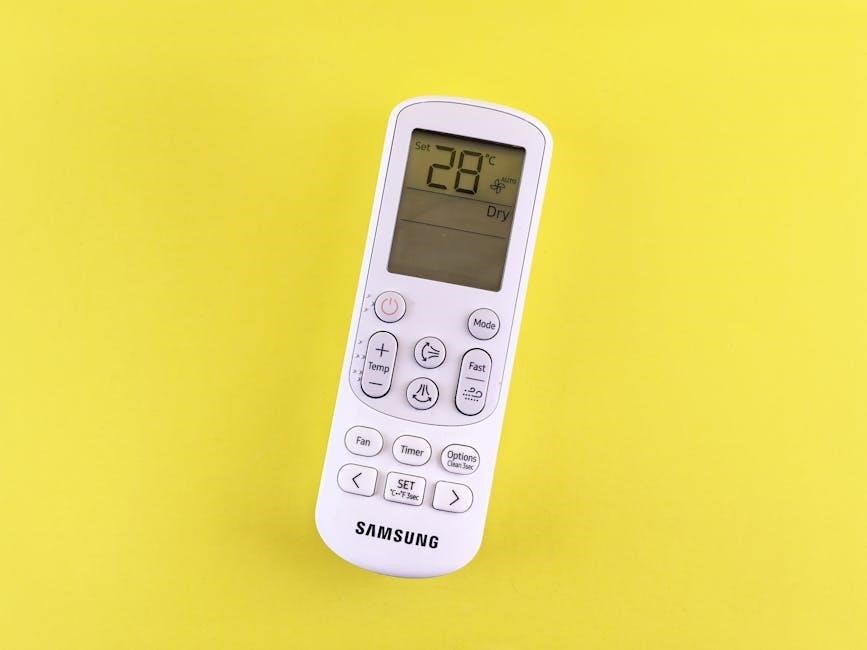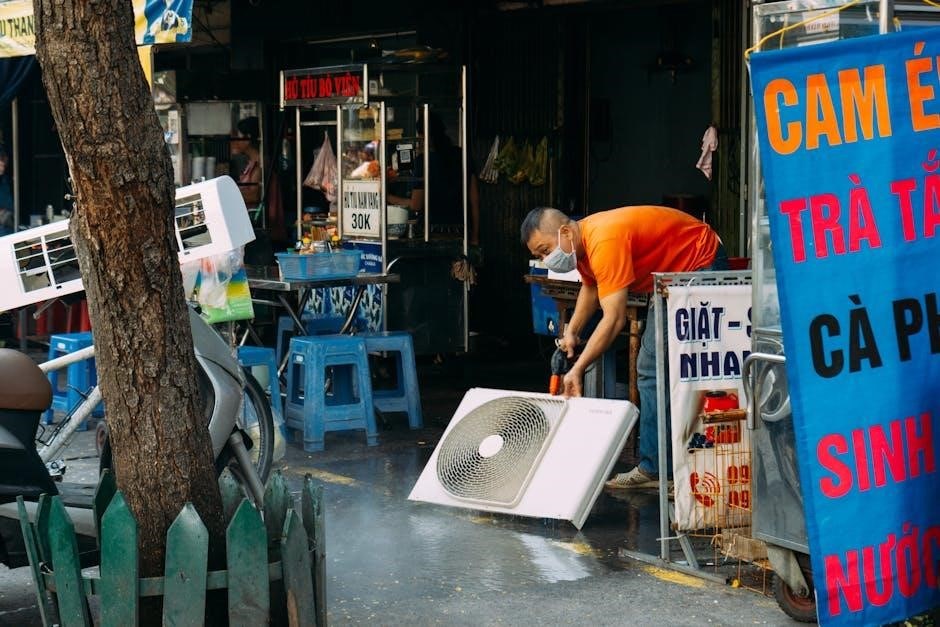Welcome to the Fujitsu Air Conditioner Manual. This guide provides essential information for safe installation‚ operation‚ and maintenance of your air conditioning unit. Ensure optimal performance and troubleshooting with detailed instructions and safety precautions for a reliable cooling experience.

Types and Models of Fujitsu Air Conditioners
Fujitsu offers a variety of air conditioner models‚ including split-type‚ duct-type‚ and cassette-type systems. Each model is designed to meet specific cooling needs‚ ensuring efficient performance and comfort in different spaces.
2.1 Split-Type Air Conditioners
Fujitsu split-type air conditioners are popular for their sleek design and efficient performance. These units consist of an indoor and outdoor component connected by refrigerant lines. They are ideal for cooling individual rooms or small spaces‚ offering quiet operation and energy efficiency. Split-type models are easy to install and require minimal space‚ making them suitable for homes‚ offices‚ and commercial settings. Many models come with advanced features like remote control‚ timer functions‚ and multiple operating modes. They are also known for their low noise levels and compact design‚ ensuring comfort without compromising aesthetics. Proper installation and maintenance are essential to ensure optimal performance and longevity of the unit.
2.2 Duct-Type Air Conditioners
Fujitsu duct-type air conditioners are designed for concealed installation‚ making them ideal for large commercial spaces or homes requiring centralized cooling. These units are installed within ductwork‚ distributing conditioned air through vents for uniform temperature control. They offer high-capacity cooling‚ energy efficiency‚ and quiet operation‚ ensuring minimal disruption. Duct-type models are suitable for buildings with complex layouts‚ providing consistent airflow and precise climate control. Professional installation is recommended due to their complex setup. These systems are perfect for environments requiring powerful‚ discreet cooling solutions‚ ensuring optimal comfort and performance in demanding settings.

2.3 Cassette-Type Air Conditioners
Fujitsu cassette-type air conditioners are designed for installation in false ceilings‚ offering a sleek and concealed cooling solution. These units are ideal for commercial spaces‚ providing powerful airflow with minimal visual impact. They feature four-way air discharge‚ ensuring even temperature distribution across rooms. Cassette-type models are known for their energy efficiency and quiet operation‚ making them suitable for offices‚ restaurants‚ and retail environments. Their compact design allows for easy integration into various spaces‚ while advanced features like automatic airflow adjustment enhance comfort. Regular maintenance‚ such as filter cleaning‚ is essential for optimal performance. These units are a practical choice for creating a comfortable and climate-controlled environment in demanding settings.

Safety Precautions
Always turn off the electrical breaker before cleaning or servicing. Avoid climbing on or hanging objects from the unit. Only qualified personnel should handle refrigerant R32 systems.
3.1 General Safety Guidelines
Always prioritize safety when operating your Fujitsu air conditioner. Ensure the unit is installed by authorized personnel to avoid hazards. Turn off the electrical breaker before cleaning or servicing. Never climb on or hang objects from the unit‚ as this can cause damage or injury. Keep the air conditioner out of reach of children and pets. Avoid exposing the unit to extreme temperatures or moisture. Follow the manufacturer’s guidelines for handling refrigerant R32 systems‚ as improper handling can be dangerous. Regularly inspect the unit for damage or wear and tear. If unsure about any procedure‚ consult the user manual or contact a professional. Adhering to these guidelines ensures safe and efficient operation of your Fujitsu air conditioner.
3.2 Specific Warnings and Cautions
Always adhere to specific warnings to ensure safe operation of your Fujitsu air conditioner. Never attempt to install or service the unit yourself‚ as it contains no user-serviceable parts. Avoid climbing on or placing objects on the unit‚ as this can lead to damage or injury. Ensure the unit is installed by authorized personnel to prevent hazards. Be cautious when handling refrigerant R32 systems‚ as improper handling can be dangerous. Keep children and pets away from the unit to avoid accidents. If unsure about any procedure‚ consult the user manual or contact a professional. Always turn off the electrical breaker before cleaning or servicing. Follow all safety guidelines to ensure reliable operation and prevent potential risks associated with air conditioner use.

Installation Guide
Ensure your Fujitsu air conditioner is installed by authorized personnel to guarantee safety and optimal performance. Follow all manufacturer guidelines and local regulations carefully.
4.1 Pre-Installation Checklist
Before installing your Fujitsu air conditioner‚ ensure the following steps are completed. Verify the unit’s compatibility with your space‚ checking dimensions and weight limits. Confirm the electrical supply matches the conditioner’s requirements‚ as specified in the manual. Ensure all necessary tools and accessories‚ such as mounting brackets and drainage kits‚ are available. Inspect the installation site for obstructions or hazards and prepare the area accordingly. Review local building codes and regulations to ensure compliance. Finally‚ ensure that only authorized personnel perform the installation to avoid safety risks and maintain warranty validity. Proper preparation ensures a smooth and safe installation process.
4.2 Step-by-Step Installation Instructions

Begin by mounting the indoor unit on a sturdy wall‚ ensuring it is level and securely fastened. Place the outdoor unit on a stable base‚ away from direct sunlight and obstructions. Connect the refrigerant pipes‚ drainage hose‚ and electrical wires between the indoor and outdoor units‚ following the manual’s specifications. Tighten all connections to prevent leaks. Power on the system and test operation in both cooling and heating modes (if applicable). Verify proper airflow and drainage functionality. Finally‚ ensure all electrical connections are safe and comply with local regulations. Refer to the manual for specific torque values and safety guidelines during installation.
4.3 Post-Installation Checks
After installation‚ perform a thorough inspection to ensure all components function correctly. Check for any refrigerant leaks by inspecting the pipe connections. Verify proper electrical connections and ensure the system is grounded. Test the air conditioner by running it in both cooling and heating modes (if applicable) to confirm smooth operation. Ensure airflow is unrestricted and the drain hose is functioning properly. Refer to the manual for specific guidelines on checking system performance. Finally‚ review the installation with a certified professional to validate compliance with safety and technical standards. This step ensures your Fujitsu air conditioner operates efficiently and safely for years to come.
Operating Instructions
This section guides you through starting the air conditioner‚ adjusting settings‚ and using advanced features. Refer to the remote control guide for seamless operation and optimal performance.
5.1 Basic Operation Overview
Start by turning on the air conditioner using the power button on the remote control. Select your desired mode—Cooling‚ Heating‚ or Fan—depending on your model. Use the temperature adjustment buttons to set your preferred comfort level. Adjust fan speed for optimal airflow. For initial operation‚ ensure the air filter is clean and all vents are unobstructed. Refer to the remote control guide for detailed button functions. Always operate the unit with the remote control for precise control. Ensure the unit is turned off when not in use to conserve energy. Follow these steps for smooth and efficient operation of your Fujitsu air conditioner.
5.2 Advanced Features and Settings
Fujitsu air conditioners offer advanced features for enhanced comfort and efficiency; Use the timer function to set start and stop times‚ optimizing energy usage. The weekly timer allows you to program operations for specific days. Adjust airflow direction and speed for precise air distribution. Some models feature automatic airflow adjustment‚ ensuring even cooling or heating. Energy-saving modes reduce power consumption while maintaining comfort. For advanced settings‚ refer to the remote control guide for detailed instructions on activating these features. These settings ensure personalized comfort and energy efficiency‚ making your Fujitsu air conditioner a sophisticated solution for home or office use.
5.3 Using the Remote Control
The remote control is an essential tool for operating your Fujitsu air conditioner. It allows you to adjust temperature‚ mode‚ and fan speed effortlessly. Use the COOL‚ HEAT‚ or FAN mode buttons to select operation type. Adjust airflow direction with the AIRFLOW button and set desired temperature using the UP/DOWN arrows. The TIMER button enables scheduling‚ while the SLEEP mode ensures energy efficiency during rest. A CHILD LOCK feature prevents accidental changes. Replace batteries when the LCD display fades. Ensure the remote is pointed directly at the unit for proper signal reception. This device enhances convenience‚ offering precise control over your air conditioner’s settings for optimal comfort.

Maintenance and Care
Regular maintenance ensures optimal performance. Clean the air filter‚ check the installation stand‚ and turn off the unit before servicing. Refer to the manual for detailed instructions.
6.1 Routine Maintenance Tasks
Routine maintenance is crucial for ensuring your Fujitsu air conditioner operates efficiently. Regularly clean or replace the air filter to maintain airflow and energy efficiency. Inspect the installation stand for stability and ensure all connections are secure. Turn off the power before performing any maintenance. Check for dust buildup on indoor and outdoor units‚ as this can reduce performance. Schedule professional servicing annually to inspect refrigerant levels‚ compressors‚ and fans. Refer to the manual for specific instructions on cleaning and servicing. Always follow safety guidelines to avoid damage or injury. Proper maintenance extends the unit’s lifespan and ensures reliable cooling and heating performance throughout the year.
6.2 Cleaning the Air Filter
Cleaning the air filter is a simple yet essential maintenance task for your Fujitsu air conditioner. A dirty filter reduces airflow‚ lowers efficiency‚ and increases energy consumption. To clean the filter‚ turn off the power and remove it from the indoor unit. Use a soft brush or vacuum cleaner to gently remove dust and debris. For stubborn dirt‚ rinse the filter with water‚ but avoid using harsh chemicals or scrubbers‚ as they may damage the filter. Allow it to dry completely before reinstalling. Clean the filter every 1-2 months‚ or more frequently in dusty environments. A well-maintained filter ensures optimal performance‚ better air quality‚ and prolonged unit lifespan.
6.3 When to Call a Professional
While routine maintenance can be done by users‚ certain issues require professional expertise. If you notice refrigerant leaks‚ unusual noises‚ or poor performance‚ contact a certified technician. Electrical problems‚ such as faulty wiring or circuit issues‚ should never be handled by amateurs. Additionally‚ if the air conditioner fails to cool or heat after troubleshooting‚ professional diagnosis is necessary. Always consult Fujitsu-authorized service providers for repairs to ensure compliance with safety standards and warranty terms. They have the tools and knowledge to address complex issues‚ ensuring your unit operates safely and efficiently. Regular professional check-ups can also prevent potential breakdowns and extend the lifespan of your air conditioner.

Troubleshooting Common Issues
Identify and resolve common issues with your Fujitsu air conditioner using this section. Check for error codes‚ power supply problems‚ or air filter blockages. Refer to the troubleshooting guide for DIY solutions or when to contact a professional. Ensure smooth operation by addressing issues promptly and safely.
7.1 Identifying Common Problems
Identifying common issues with your Fujitsu air conditioner is crucial for maintaining efficiency and comfort. Start by checking error codes displayed on the remote control or unit‚ as they often indicate specific malfunctions. Common problems include insufficient cooling‚ unusual noises‚ or water leakage. Verify if the air filter is clean‚ as blockages can reduce performance. Ensure proper installation and power supply. If the unit does not turn on‚ check circuit breakers or fuses. For cooling issues‚ inspect refrigerant levels or blockages in vents. Strange noises may signal loose parts or compressor problems. Refer to the troubleshooting section for detailed solutions or consult a professional if issues persist. Regular maintenance can prevent many of these problems. Always prioritize safety when diagnosing or repairing your air conditioner;
7.2 Understanding Error Codes
Fujitsu air conditioners often display error codes to indicate specific issues. These codes‚ such as E1‚ E2‚ or E3‚ help diagnose problems like sensor malfunctions‚ refrigerant leaks‚ or compressor faults. Refer to your manual or the manufacturer’s website for code meanings. For instance‚ E1 may signal a room temperature sensor issue‚ while E3 could indicate a fault in the outdoor unit. Understanding these codes allows you to address problems promptly. If issues persist‚ consult a professional. Regular checks can prevent errors‚ ensuring reliable operation. Always follow safety guidelines when troubleshooting. Use official resources for accurate interpretations and solutions. This helps maintain your unit’s efficiency and longevity. Error codes are essential tools for effective troubleshooting and maintenance.
7.3 DIY Repair Solutions
For minor issues with your Fujitsu air conditioner‚ DIY repairs can save time and money. Start by checking and cleaning the air filter‚ as a clogged filter can reduce efficiency. Ensure the unit is turned off before performing any maintenance. If the air conditioner isn’t cooling‚ verify that the remote control batteries are functional and settings are correct. Check for proper installation and ensure the outdoor unit is free from obstructions. For issues like water leakage‚ inspect the drain pipe and ensure it’s clear. Refer to your manual for guidance on resetting error codes or restarting the unit. However‚ for complex problems like refrigerant leaks or compressor faults‚ always consult a certified technician. DIY solutions are best for simple‚ non-technical fixes‚ ensuring safety and maintaining warranty validity. Always follow safety precautions and manufacturer guidelines when attempting repairs.

Technical Specifications
This section provides detailed technical information‚ including electrical requirements‚ dimensions‚ noise levels‚ and environmental considerations‚ ensuring compatibility and proper installation of your Fujitsu air conditioner.
8.1 Electrical Data and Requirements
Fujitsu air conditioners require specific electrical connections to ensure proper operation. Models like the Fujitsu ASHA18LEC operate on 220-240V AC‚ with a frequency of 50Hz. The power consumption varies by model‚ ranging from 1.3kW to 2.2kW for cooling and heating modes. Always check the unit’s rating plate for exact electrical data. Use a dedicated 15-20 amp circuit to avoid overload risks. Install a circuit breaker or disconnect device near the outdoor unit for safe servicing. Ensure all connections comply with local electrical codes and regulations. Improper wiring can lead to unit damage or safety hazards. Refer to the specific model’s manual for precise electrical requirements and wiring diagrams to ensure compatibility and safety. Proper installation by a licensed technician is highly recommended to meet these specifications.
8.2 Dimensions and Space Requirements
Fujitsu air conditioners are designed to fit various spaces‚ with dimensions varying by model. Indoor units like the ASU9RL2 measure 890mm (width) × 290mm (height) × 200mm (depth)‚ while outdoor units like the AOU9RL2 are 840mm × 540mm × 290mm. Ensure adequate space for proper airflow and maintenance. For split-type models‚ maintain at least 30cm clearance around the outdoor unit. Duct-type units require larger spaces for installation. Cassette-type models need ceiling space for mounting. Always check the manual for specific dimensions and installation guidelines. Proper spacing ensures efficient operation‚ safety‚ and compliance with manufacturer recommendations. Consult a professional for precise measurements and installation planning to avoid issues. This ensures optimal performance and longevity of your Fujitsu air conditioner.
8.3 Noise Levels and Operational Decibels
Fujitsu air conditioners are designed to operate quietly‚ ensuring minimal disturbance in homes and workplaces. Indoor units typically have noise levels ranging from 32 to 40 decibels (dBA)‚ while outdoor units generally operate at 48 to 55 dBA. These low noise levels are achieved through advanced fan and compressor technologies. For instance‚ the ASU9RL2 indoor unit operates at 32-40 dBA‚ making it suitable for bedrooms and living areas. Outdoor units like the AOU9RL2 run at 48 dBA‚ ensuring they won’t disrupt outdoor activities. The quiet operation enhances comfort and usability‚ making Fujitsu air conditioners ideal for both residential and commercial settings. Proper installation and maintenance help maintain optimal noise performance. Always refer to the manual for specific noise levels of your model.
8.4 Environmental Considerations
Fujitsu air conditioners are designed with environmental responsibility in mind. Many models use R32 refrigerant‚ which has a lower environmental impact compared to older refrigerants. Energy-efficient technologies‚ such as inverter compressors‚ reduce power consumption and minimize carbon footprint. Proper disposal of old units is crucial‚ and Fujitsu recommends recycling or following local regulations for environmentally safe disposal. Additionally‚ users are encouraged to switch to eco-friendly modes to reduce energy usage. Fujitsu also complies with international energy efficiency standards‚ ensuring their products contribute to a greener future. Always refer to local guidelines for environmentally responsible operation and disposal of your air conditioner.

Additional Resources
For further assistance‚ visit Fujitsu’s official website for downloadable service manuals‚ user guides‚ and detailed product specifications. Ensure to use the correct model number for accurate resources.
9.1 Fujitsu Service Manuals
Fujitsu service manuals provide detailed technical specifications‚ diagrams‚ and repair guidance for authorized personnel. These manuals are essential for troubleshooting and maintaining specific models‚ ensuring compliance with safety and operational standards. Available for download as PDFs‚ they cover split-type‚ duct-type‚ and cassette-type air conditioners‚ including models like AUTG18LVLA and AUTG24LVLC. Each manual includes electrical data‚ dimensions‚ and noise level specifications‚ aiding professionals in accurate installations and repairs. Visit Fujitsu’s official website or authorized service portals to access these resources‚ ensuring you have the correct model number for precise information. These documents are crucial for technicians and service providers to maintain unit performance and longevity.
9.2 User Manuals and Guides
Fujitsu user manuals and guides are designed to help users understand and operate their air conditioning systems effectively. These manuals provide detailed instructions on safety precautions‚ installation requirements‚ and daily operation. They also cover advanced features such as remote control functionality‚ timer settings‚ and energy-saving modes. Available in PDF format‚ these guides are accessible online and cater to various models‚ including split-type‚ duct-type‚ and cassette-type air conditioners. Users can download these resources from Fujitsu’s official website or authorized portals‚ ensuring they have the most up-to-date information. By referring to these manuals‚ users can optimize their unit’s performance‚ troubleshoot common issues‚ and maintain their air conditioner’s efficiency and longevity.
